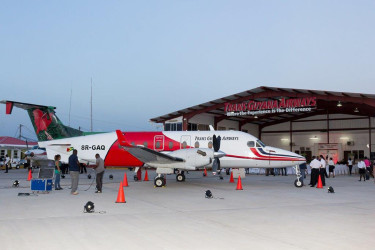If the recently acquired 19-seater Rayethon Beechcraft 1900 D is to provide optimum service to the country’s aviation sector it will have to benefit from upgraded domestic infrastructure including, particularly, an improved network of airstrips at several interior locations.
Last week Stabroek Business sat down with Trans Guyana’s Chief Executive Officer Michael Correia who spoke enthusiastically about how the recent acquisition could enhance the capacity of the country’s air transport sector whilst adding a generous measure of prestige to its aviation industry. Apart from plans to utilize it to provide service to various interior locations and to fly visitors to the Kaieteur Falls, Correia spoke with Stabroek Business about the regional and hemispheric prospects for the new aircraft.
In the matter of the aircraft’s domestic operations, however, Correia has raised once again the issue of the condition of several interior airstrips and whether or not his company’s whopping US$4 million investment in an aircraft intended to enhance the country’s aviation sector ought not to give reason for official efforts to upgrade interior airstrips.

In his exchange with Stabroek Business last week, Correia set out some of the envisaged services which the new aircraft will provide both locally and in the region, identifying at least eight airstrips that could host the recently acquired aircraft. All of them are mentioned in a broader list of airstrips that appear on a 2015—2017 schedule, which Stabroek Business has seen, proposed for upgrading “to accommodate larger aircraft.” Each airstrip possesses a particular relevance to the Guyana economy.
The proposal for the upgrading of the Kaieteur airstrip envisages the extension of the existing runway to bring the airstrip up to 4,000x100ft. Additionally, upgrading work will have to include the blasting of rock, clearing of vegetation and the purchase and transporting of materials to the site. The cost of upgrading the runway between the remainder of 2015 and next year is estimated at $250,000.
Lethem, a key interior port of entry and a popular destination for tourists will require the extension of the existing runway to 6,400 ftx100 ft as well as the layering of bitumen on the extended runway and the removal of waves and resurfacing. Estimated 2015/2016 upgrading costs total $100,000.
Other airstrips connected to the interior’s farming, mining and tourism sectors and which are likely to be used by the new Trans Guyana Aircraft include those at Port Kaituma, Annai, Kamarang, Matthews Ridge, Imbaimadai and Baramita. All told, the upgrading work recommended for these eight airstrips up to 2016 is estimated at $790,000 and costs include inspections.
The overall domestic airstrips rehabilitation budget (2015-2017) is stated as $460,000 and takes account of widening, re-surfacing, lengthening and conducting routine maintenance at nine airstrips including those at Eteringbang, Kurupung, Bartica and Aishalton.
The domestic airstrip maintenance budget for 23 airstrips is stated as $105,000.
In his address to mark the commissioning of the 1900D aircraft on September 17 at Ogle, Correia had asserted that “the condition of our hinterland airstrips is worse now, than when GAC operated its HS748 50-seater aircraft in the interior, in the 1970s.” He said that the request by aircraft owners for US$7.5 million to be invested in aviation infrastructure over a three-year period “at least to put us back on track with the GAC days” had been “continuously ignored” by the previous minister. “Instead,” the Trans Guyana CEO said, “large sums of money have been allocated for politically, rather than development driven, priorities.”
Aircraft owners, Correia said, could not understand “the cost benefit of spending US$150 million on one airport alone,” while allocating insignificant expenditure to several others.
In his address, Correia also alluded to the fact that the country’s civil aviation authority ‘is operating below the international standard required to regulate an industry which is the busiest in the Caribbean, which is using complex aircraft and which is flying over extremely challenging territory.” Additionally, he alluded to the fact that the local aviation sector “has had no resident Flight Operations Inspector on staff for many years,” that our aviation laws need to be upgraded” and that “we are operating below the standard of Trinidad and Tobago, Jamaica, Barbados and the Eastern Caribbean.”




